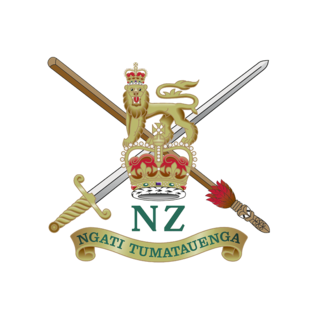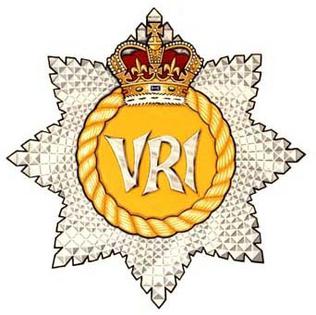
The New Zealand Expeditionary Force (NZEF) was the title of the military forces sent from New Zealand to fight alongside other British Empire and Dominion troops during World War I (1914–1918) and World War II (1939–1945). Ultimately, the NZEF of World War I became known as the First New Zealand Expeditionary Force. The NZEF of World War II was known as the Second New Zealand Expeditionary Force (2NZEF).

The Royal Canadian Regiment is an infantry regiment of the Canadian Army. The regiment consists of four battalions, three in the Regular Force and one in the primary reserve. The RCR is ranked 1st in the order of precedence amongst Canadian Army infantry regiments, but in a quirk of the rules of seniority, its 4th battalion is 9th.
The Royal New Zealand Infantry Regiment is the parent administrative regiment and corps of regular and reserve infantry battalions in the New Zealand Army. It was originally formed in 1947 with a singular Regular regiment and multiple reserve regiments. Over time, the regiments were turned into battalions, the reserve units amalgamated and more regular units raised and disbanded. Currently, the Regiment currently consists of two regular and three reserve battalions. Throughout its existence, units raised in this regiment have served and deployed on operations in Malaya, Vietnam, Borneo and various United Nations peacekeeping operations.

The New Zealand Mounted Rifles Brigade was a brigade of the New Zealand Army during the First World War. Raised in 1914 as part of the New Zealand Expeditionary Force, it was one of the first New Zealand units to sail for service overseas.

The Waikato Mounted Rifles (WMR) is the New Zealand Army's only Territorial Force squadron of the Royal New Zealand Armoured Corps (RNZAC). The Squadron's origins can be traced back to 1869 when the first mounted unit was raised in the Waikato. Today the Squadron is part of Queen Alexandra's Mounted Rifles (QAMR) where it forms the regiment's reserve squadron. WMR's role is mounted reconnaissance and surveillance.
The Wellington West Coast and Taranaki Regiment was a Territorial Force unit of the New Zealand Army. It was originally formed in 1948 by the amalgamation of two separate regiments:

The Cameronians was a rifle regiment of the British Army, the only regiment of rifles amongst the Scottish regiments of infantry. It was formed in 1881 under the Childers Reforms by the amalgamation of the 26th Cameronian Regiment and the 90th Perthshire Light Infantry. In 1968, when reductions were required, the regiment chose to be disbanded rather than amalgamated with another regiment, one of only two infantry regiments in the British Army to do so, with the other being the York and Lancaster Regiment. It can trace its roots to that of the Cameronians, later the 26th of Foot, who were raised in 1689. The 1881 amalgamation coincided with the Cameronian's selection to become the new Scottish Rifles.
The 13th Infantry Brigade was a regular infantry brigade of the British Army that saw active service during both the First and the Second World Wars.

The 52nd Infantry Brigade was a formation of the British Army, which was first formed in 1914 as part of Kitchener's Army. The brigade was disbanded in 1919, but reformed in British India during the Second World War and disbanded in 1945. It was again formed in 1982, and existed until 2010.

The Victoria Rifles of Canada was an infantry regiment of the Canadian Army that originated in Montreal, Quebec, on 22 January 1862, as The 3rd Battalion Volunteer Militia Rifles Canada. The regiment went through several changes of designation throughout its history. It was redesignated as the 3rd Battalion, The Victoria Volunteer Rifles of Montreal on 18 July 1862; as the 3rd Battalion Victoria Rifles of Canada on 5 December 1879; as the 3rd Regiment Victoria Rifles of Canada on 8 May 1900; as The Victoria Rifles of Canada on 29 March 1920; as Victoria Rifles of Canada on 15 November 1934; as the 2nd (Reserve) Battalion, Victoria Rifles of Canada on 7 November 1941; and finally Victoria Rifles of Canada on 1 June 1945. It was reduced to nil strength and transferred to the Supplementary Order of Battle on 5 March 1965.

The 140th Brigade was an infantry brigade formation of the British Army's Territorial Army (TA) that had its origins in a South London Brigade of the former Volunteer Force. It served on the Western Front in the First World War and was recreated during the Second World War where it served only in the United Kingdom as a training formation.

The Capture of Jisr ed Damieh took place on 22 September 1918 during the Third Transjordan attack of the Battle of Nablus which, along with the main Battle of Sharon formed the Battle of Megiddo fought during the Sinai and Palestine Campaign of the First World War. Units of Chaytor's Force under the commanded by Brigadier-General William Meldrum, and known as "Meldrum's Force", attacked and captured the bridge. This successful attack cut the most direct line of retreat from the Judean Hills for the Seventh and remnants of the Eighth Armies, while units from these two armies were moving towards, and crossing the Jisr ed Damieh bridge over the Jordan River. This victory by Meldrum's Force opened the way for Chaytor's Force to advance along the main Nablus to Es Salt road to capture Es Salt and to continue on to the victory at the Second Battle of Amman.

The Battle of Ayun Kara was an engagement in the Sinai and Palestine Campaign during the First World War. The battle was fought between the New Zealand Mounted Rifles Brigade and a similar-sized rearguard from the Turkish 3rd Infantry Division, which was part of the XXII Corps of the Ottoman Eighth Army under Kress von Kressenstein.

The 5th/7th Battalion, Royal New Zealand Infantry Regiment is an Army Reserve infantry battalion of the Royal New Zealand Infantry Regiment with its headquarters in Trentham, New Zealand.

The Battle for No.3 Post was fought during the Gallipoli Campaign in the First World War, between the forces of the New Zealand Mounted Rifles Brigade and the Turkish 19th Division.
Otago Regiment may refer to:

The Taranaki Regiment was a territorial infantry regiment of the New Zealand Military Forces. The regiment traced its origins to the Taranaki Volunteer Rifle Company, a volunteer corps formed in 1858 and which saw service in the New Zealand Wars. The volunteer corps also provided men to the New Zealand contingents sent to South Africa during the Second Boer War and in 1911 became the 11th Regiment . During the First World War, the regiment provided a company to each of the battalions of the Wellington Infantry Regiment and saw combat at Galipolli and on the Western Front. After the war the regiment was renamed the Taranaki Regiment and remained in New Zealand for home defense during the Second World War. Men from the regiment, however, served with the 19th, 22nd, 25th and 36th Battalions of the Second New Zealand Expeditionary Force. In 1948, the Taranaki Regiment was amalgamated with the Wellington West Coast Regiment and became the Wellington West Coast and Taranaki Regiment.

The Wellington Regiment was a territorial infantry regiment of the New Zealand Army. The regiment traced its origins to the Wellington Veteran Volunteer Corps, a volunteer corps formed in 1867 and which would later amalgamate with other volunteer corps to form the 5th (Wellington) Regiment in 1911. During the First World War, the regiment was first sent to capture German Samoa in August 1914 and was later affiliated with the New Zealand Rifle Brigade which saw combat on the Western Front. After the war, the regiment was renamed the Wellington Regiment and remained in New Zealand for home defence during the Second World War. Men from the regiment, however, served with the 19th, 22nd, 25th and 36th Battalions of the Second New Zealand Expeditionary Force. In 1964, the Wellington Regiment was amalgamated with the Hawkes Bay Regiment to become 7th Battalion, Royal New Zealand Infantry Regiment.













